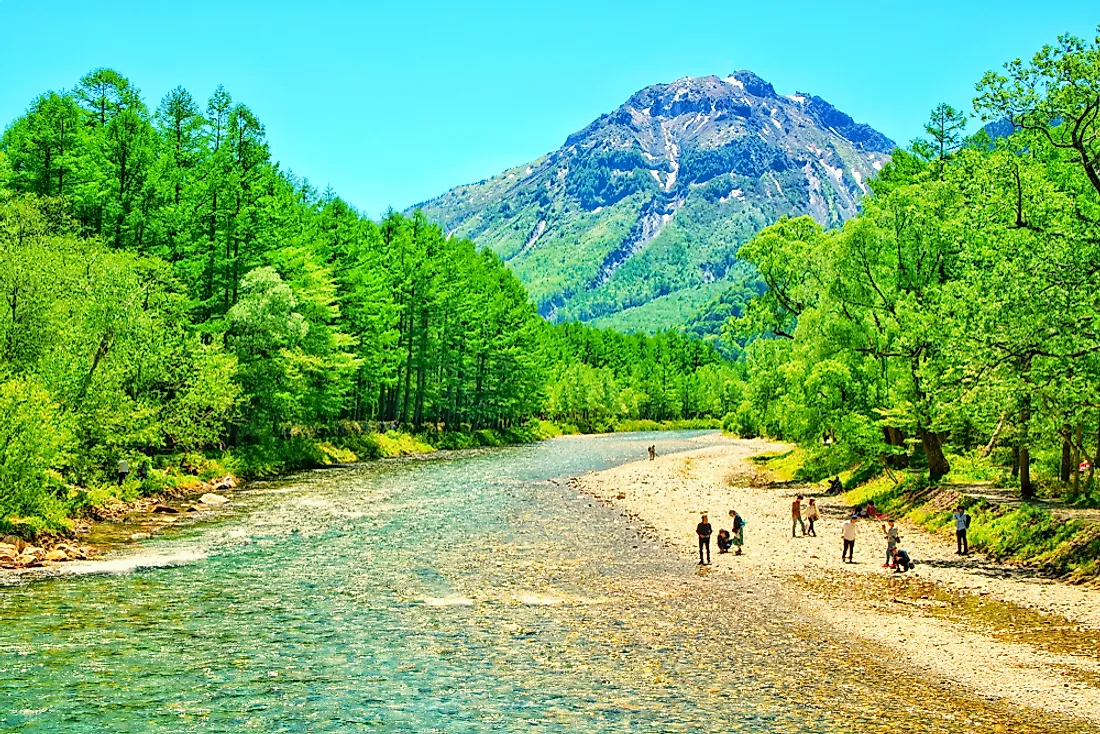Where are the Japanese Alps?

The Hida, Kiso, and Akaishi Mountain Ranges divide the Japanese island of Honshu into two parts. They span across the Nagano, Toyama, Gifu, Yamanishi, and Shizuoka prefectures in Japan. The Hida Mountains have a Y-shaped form, with a deep valley between the forks of its "Y". The northern peaks are located in the fork of the "Y", and its southern peaks are in the opposite, lower portion. The Kiso Mountains, a granitic range, is also referred to as the Central Alps, and has two rivers flowing through them which are ultimately seen reaching the Pacific Ocean. The Akaishi Mountains are in the southern portion of the Japanese Alps, and shares one of the two rivers with the Kiso range, and have one of their own rivers as well that also empties out into the Pacific Ocean.
4. Historical Role
William Gowland, a 19th Century British mining engineer, gave the name "Japanese Alps" to the Hida Mountains only, which today are also referred to as the Northern Alps. The Kiso and Akaishi Mountain range were only included in the Japanese Alps category in later years. The Hida Mountains also have the Kurobe Dam at their center, while the Kiso Mountains is the more popular tourist destination areas, and one of its peaks has a ropeway that leads to its top. The Akaishi Mountains is referred to as the Southern Alps, and portions of it are part of the Minami Alps National Park. British Anglican missionary Walter Weston wrote a book on the Japanese Alps in 1896 that popularized the Japanese Alpine peaks among western mountaineers. Weston also helped make mountain climbing a popular pastime in Japan.
3. Modern Significance
The Japanese Alps is today a year-round tourist destination area that attracts eco-tourists and mountaineers alike, and some of its peaks reach over 10,000 feet in altitude. Mount Hotaka's peak (a.k.a. Hotakadake or Okuhotaka) reaches 10,466 feet, while Mount Kita reaches 10,476 feet. Komagatake peak, Senjogatake peak, and Akaishi-dake peak also reach beyond the 10,000-foot mark. The Central Japan National Park has authority over the Japanese Alps, and features many destinations that are open year-round. The Hakuba Ski Resort is just one of the premier spots to visit in the wintertime. The whole area seems to be a natural showcase of seasonal autumn colors as well. The journey to, and time within, the Japanese Alps make visits here unforgettable. Some of the mountain towns have historical significance, and several have therapeutically curative hot springs. Tourists can enjoy local cuisine and excellent local wines in many places along the way as well.
2. Habitat and Biodiversity
Semi-tropical forests and their characteristic fauna mark certain areas in the lower portions of the park, while Alpine forest habitats dominate the higher altitudes of the Japanese Alps. Siberian Dwarf Pines, Stone Pines, Beeches, and Hemlock-Spruces thrive in these forests. A number of avian species are well represented in the area as well, notably including Rock ptarmigans and Spotted nutcrackers. Ungulates are commonly found on the slopes and lowlands alike, with the Japanese serow leading in numbers among them while the famous Kamoshika (or goat-deer) is also abundant. Sika deer, wild boars, and Asiatic black bears also roam these forest habitats. Humans have minimal facilities available to them in the park, and the only way in and out is by hiking. The Tenryu River, Oi River, Fuji River, and Kiso River are the major waterways found in this mountainous area. All of these rivers arise from sources on the slopes of the Japanese Alps, and flow down towards the Isle Bay before draining into the Pacific Ocean.
1. Environmental Threats and Territorial Disputes
Industrial wastes count as the biggest environmental threats on the island of Honshu where the Japanese Alps are found. These threats range from Cadmium leaks and methyl-mercury leaks to sulfur dioxide pollution and nitrogen dioxide emissions. Other human threats come from photochemical smog and arsenic poisoning from mines. The Japanese citizens also know about their country's problems regarding their acidic rainfall, their contribution to ozone layer destruction, desertification, and deforestation. Many Honshu locals have voiced their concerns over water and air pollution as additional worries. Endangered species in the region, including plants, mammals, and fishes alike, are another real and ongoing concern. A newer problem is the increased levels of electronic waste that are being disposed into Honshu's landfills, while nuclear waste may pose the gravest threat of all to the environment and humans. In fact, Honshu is home to Hiroshima, where the United States dropped an atomic bomb during the late stages of World War 2 in 1945. Many survivors were scarred for life and increasingly prone to cancers and other radiation-related ills. These problems have been addressed time and again by the Japanese government since the 1950s and 1960s, yet still are contributing to negative health outcomes among both humans and wildlife.











